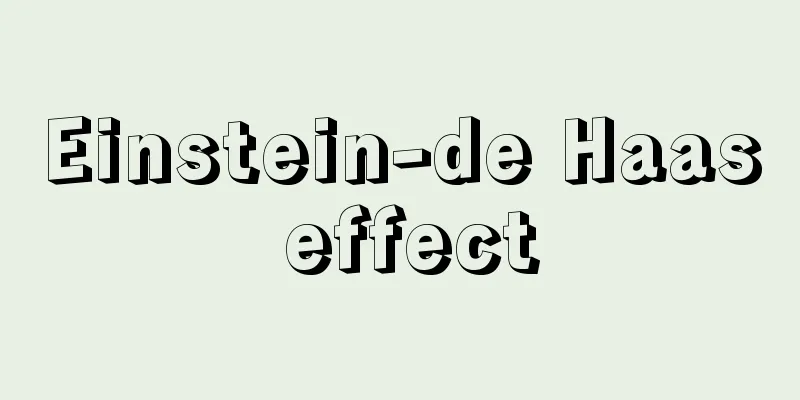Fish finder - echo sounder

|
This is a machine that emits ultrasonic waves into the water from a fishing boat and displays the distance to the school of fish or the seabed from the reflected waves. It is also called a fish finder for short. There are two methods: one that emits ultrasonic waves vertically from the fishing boat and one that emits them horizontally. It evolved from an echo sounder necessary for safe navigation of ships, and basically consists of an ultrasonic oscillator, an ultrasonic transmitter, an ultrasonic receiver, and a recorder. [Tetsuya Shimamura and Hideo Soeda] Principle and OutputThe principle is that an oscillator is operated to convert electrical vibrations into ultrasonic waves, which are then emitted into the water through a transmitter. When this hits a school of fish (a reflector), it is reflected, and the reflected waves are received by a receiver, which then amplifies them. The reflected image is output from the recorder onto recording paper using a recording pen. The recording paper is wound at right angles to the recording pen, providing a continuous record, allowing the time progression of the record to be known. The emitted ultrasonic waves are reflected off anything in the direction of propagation, not just schools of fish. Therefore, the recording paper records schools of fish, the seabed, fishing gear, plankton layers, and other things. The reflected waves can be displayed using recording paper (wet or dry), cathode ray tubes, neon tubes, and other methods. Fish finders have also become increasingly digitalized, allowing the water depth to be read directly on a CRT (Cathode Ray Tube, a type of cathode ray tube) while sailing, and the strength of the reflected waves can be displayed in different colors. Generally, strong reflections are colored red and weak reflections blue, with the display using 8 to 16 colors. In addition, the data can be saved on a memory medium by connecting directly to a computer. As a result, the types that use recording paper are becoming less popular. Fish finder records include the distance to the schools of fish, the species or size of the fish, and information about the seabed, such as the water depth, bottom type, and seabed shape. Some models are also linked to the Global Positioning System (GPS) to obtain information on the locations where dense schools of fish have been found. The ultrasonic frequencies used range from 10 kHz to 400 kHz. Taking advantage of the characteristics of ultrasonic waves at different frequencies, machines that use multiple high and low frequencies and switch between them depending on the purpose are often used. [Tetsuya Shimamura, Hideo Soeda, and Kiyoshi Yoshihara] Sonar DevelopmentThere are also horizontal fish finders (horizontal sonars) that emit ultrasonic waves not only vertically but also horizontally. These are searchlight-type sonars that rotate the transducer horizontally to search for the distribution of fish in the vicinity. Fishing boats are equipped with models suited to the purpose of each type of fishing. They are very widely used and are important fishing equipment. Fish finders were first imported to Japan by the Ministry of Agriculture and Forestry from the UK and the US in 1928 (Showa 3), but the first scanning sonar for fishing boats was developed in Japan in 1972 (Showa 47). This system emits ultrasonic transmission pulses from a transducer in all directions in a horizontal plane, omnidirectionally, and uses an electronic scanner to rotate only a sharp ultrasonic beam at high speed without rotating the underwater receiver, and displays the same PPI (Plan Position Indication) as a radar on a CRT. Conventional searchlight sonars search for schools of fish around a fishing boat by rotating the transducer 360 degrees, which takes time to search in all directions. However, this scanning sonar can instantly determine not only the distribution of schools of fish but also their movement, making it particularly effective in purse seine fishing, which requires rapid tracking of schools of fish. Furthermore, in order to not only know the distribution location of fish schools but also to grasp the quantity and density of fish schools more accurately, an integral type quantitative fish finder was developed that can digitize and display the quantity of fish schools. Quantitative fish finders are also called scientific fish finders, which is the Japanese translation of Simrat's product name "Scientific Echo Sounder." Quantitative fish finders use the fact that a relatively wide ultrasonic beam is emitted from the transmitter, and the total echo from targets contained within it is proportional to the sum of the echo energy reflected by each fish in the school, and integrate this over the entire school of fish to find the density and quantity. Fish finders were developed primarily for fishing purposes, but as they have become more digitalized, they have become smaller and lighter, and are now available at relatively low cost for leisure use, even wristwatch-like models that can be installed on pleasure boats or used while boat fishing. [Tetsuya Shimamura, Hideo Soeda, and Kiyoshi Yoshihara] [Reference item] | | | | | | |Source: Shogakukan Encyclopedia Nipponica About Encyclopedia Nipponica Information | Legend |
|
漁船から水中に超音波を発射し、その反射波から魚群または海底までの距離を表示する機械である。略して魚探ともいう。漁船から鉛直方向に超音波を発射する方法と水平方向に発射する方法がある。船舶の安全航行に必要な音響測深機から発展したもので、原則として超音波発振器、超音波送受波器、超音波受信器、記録器で構成されている。 [嶋村哲哉・添田秀男] 原理と出力原理は、発振器を作動させ電気振動を超音波に変換し、送波器を通して水中に超音波パルスを発射する。これが魚群(反射体)に当たると反射し、返ってきた反射波を受波器で受け、受信器で増幅する。出力方法は記録器から記録紙に記録ペンによって反射像が記録される。記録紙は記録ペンと直角に巻き取られるので連続した記録が得られ、記録の時間的な経過を知ることができる。発射された超音波は、魚群に限らず伝搬方向に存在するあらゆるものに当たって反射する。したがって、記録紙には、魚群をはじめ海底、漁具、プランクトン層、その他が記録される。反射波の表示方法には、記録紙(湿式、乾式)によるほか、ブラウン管式、ネオン管式などがある。 魚群探知機もデジタル化が進み、航走しながらCRT(Cathode Ray Tubeの略。陰極線管の代表であるブラウン管をさす)上で水深が直読でき、反射波の強さに応じて色分けして表示できるようになった。一般に強い反射を赤系統、弱い反射を青系統とし、8~16色で表示される。また、パソコンと直結して記憶媒体に保存し残すことができる。したがって記録紙を用いるタイプは減少しつつある。 魚群探知機の記録では、魚群までの距離、魚種あるいは魚群の大きさなど、海底情報としては水深、底質、海底形状などがわかる。さらにGPS(全地球測位システム)と連動して濃密魚群が発見された位置の情報も得られる機種もある。使用される超音波の周波数は10キロヘルツから400キロヘルツの範囲である。周波数が異なるときの超音波の特徴を生かし、目的に応じて周波数を切り換える高低複数の周波数併用型の機械が多く用いられている。 [嶋村哲哉・添田秀男・吉原喜好] ソナーの開発超音波を鉛直方向だけでなく水平方向に発射する水平魚群探知機(水平ソナー)もある。周囲の魚の分布状況を探索するため送受波器を水平方向に回転させるサーチライト型のソナーである。漁船は漁業種類に応じてそれぞれの目的に適した機種を装備する。普及率は非常に高く、重要な漁業機器である。 魚群探知機は1928年(昭和3)イギリスとアメリカから農林省が初めて日本に輸入したが、1972年(昭和47)に漁船用としては日本で最初のスキャニングソナーが開発された。これは、超音波の送信パルスを送受波器から水平面内に無指向性で全方位に発射させ、電子スキャナーを使い、海中の受波器を回転することなく鋭い超音波ビームのみを高速回転させ、CRT上に、レーダーと同じPPI(Plan Position Indication)表示をする方式である。従来のサーチライト型ソナーでは、送受波器を360度回転することにより漁船の周囲の魚群を探索したので、全方位の探索に時間がかかっていた。しかし、このスキャニングソナーでは、魚群の分布だけでなく移動状況も瞬時に判明するので、魚群の追跡に迅速性を必要とする巻網漁において、とくに効果をあげている。 また、魚群の分布位置を知るだけでなく、さらに魚群の量および密度をより正確に把握するため、魚群量をデジタル化した後に表示できる積分方式の計量魚探が開発された。計量魚探は、科学魚探とよばれることもあるが、これはシムラット社の商品名「Scientific Echo Sounder」の和訳である。計量魚探は、送波器から比較的広い超音波ビームを出し、そのなかに含まれる物標からの総反響が、魚群の1尾ごとに反射する反響エネルギーの和と比例することを利用、魚群全体にわたってこれを積分し、密度や量をもとめる方式である。 魚群探知機はおもに漁業用として発展してきたが、デジタル化が進み、小型軽量化が可能になり、レジャー用としてプレジャーボートに搭載あるいはボート釣りに用いられる腕時計様の物まで比較的安価で手に入れることができる。 [嶋村哲哉・添田秀男・吉原喜好] [参照項目] | | | | | | | |出典 小学館 日本大百科全書(ニッポニカ)日本大百科全書(ニッポニカ)について 情報 | 凡例 |
Recommend
Money
…In contrast to special days, ordinary days were ...
The Land of Izumo
A woman who is said to have laid the foundations o...
Boulton, M.
…Although it was a local organization consisting ...
Ryogetsu Ishimura
1879-1938 A biwa (Japanese lute) performer from t...
Val del Bove (English spelling)
...The mountain has a volume of 1000 km3 , making...
Palmyra
An ancient city in central Syria. Under Roman rule...
Management science
It literally means the scientific method of manage...
Carpo (English spelling)
Jupiter's 46th moon. Its orbital inclination t...
Cakravartirāja (English spelling)
...When this king appears in the world, a heavenl...
Capsa - Capsa
...It arose toward the end of the Pleistocene, fo...
Caterpillar
A skin disease caused by the parasitic fungus tin...
dhimotiki mousikiki (English spelling) dhimotikimousiki
...Today's traditional Greek music is charact...
Vestalis
…Tradition says that Numa, the second king, insti...
Dupré, L.
…In the early days, Pierre Beauchamp (1636-1705) ...
God-man
〘Noun〙① A lower-ranking priest or yoriudo who serv...









